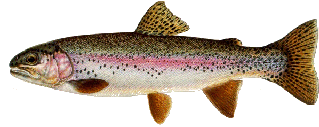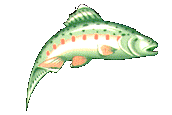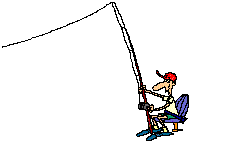

p
This information on Whirling disease is something that I researched and wrote a paper on. I became interested in learning more about the disease when it became a big issue in the Northwest. This disease is infecting and devastating the population of prized trout in our surrounding waterways and other Northwest states. I figure there are more people besides myself that are interested about this disease, so I decided to enter the information within my site.
Abstract
Whirling disease is a disease of young salmonoids which is found all over the world. This disease can be crippling and sometimes fatal. This disease gets its name AWhirling@ because when infected the fish start swimming in a tail chasing behavior. Whirling disease is caused by a microscopic waterborne protozon parasite which attacks the cartilage of young trout. The terminology for this parasite is also known as Myxobolus cerebralis (also known as Myxosoma cerebralis). The infection is caused by a parasite with a two-stage life cycle. The disease has been detected in various fish hatcheries and bodies of water around the United States.


Whirling Disease
Whirling disease is a disease of young salmonoids (trout fry and fingerlings). It can also be considered a chronic disease of trout fry and fingerlings. This disease can be crippling and sometimes fatal.
The disease adopted its name because of the tail-chasing,
Awhirling@ around in circles when young fish are startled or fed. When infected, the young fish swim in an erratic motion which can result in starvation and eventually death (Maria E. Markiw, Salmonoid Whirling Disease leaflet, 1992).Whirling disease is caused by a microscopic, waterborne, protozone parasite that attacks the cartilage of young trout. The parasite is smaller than a grain of sand, which makes it impossible to see with a naked eye. The parasite attacks the trout
=s nervous system, forming on cartilage where the parasite is believed to obtain nutrition. As the parasites grow, they destroy the cartilage.In young fish this can result in abnormalities such as deformed heads, crooked jaws, twisted spines and snub nose snouts (similar to a spawning salmon). Scientists presume the symptoms are caused by pinched nerves which throws the equilibrium of the fish off. The pinched nerves cause the fishes immune system to engulf the infected area with white blood cells, which creates swelling.
ABlack tail@ is another term associated with whirling disease. The fish pigment on the tail of the fish turns a blackish\purple color which is caused by the pinching of the nerves.
The terminology for this parasite is also known as Myxosporeans (
Myxobolous cerebralis or Myxsoma cerebralis). Myxobolus cerabralis is a microscopic spore that generates whirling disease and is presumed to be among one of the oldest forms of life. Drastically hardy, the spore lives in carcasses and bones of diseased fish up to 30 years after the fishes death. The spore can even survive digestion, living in the feces of fish, or predators and joining to the danger that animals and birds will carry the disease to nonconnecting bodies of water. Myxosporeans are frequently encountered parasites in the tissues of wild and cultured fishes. Myxobolus cerebralis, Ceratomyxa shasta, and PKX are affiliated with the death of salmonoids. PKX is the causative agent of proliferative kidney disease (R.P. Hedrick, A.Wishkovsky, J.C. Modin, R. J. Toth, 1991, Journal of Aquatic Animal Health p. 55-62, 1991).Myxosporean infections are for the most part relatively harmless, with insignificant or medium host reactions. Usually it takes a large amount of the infection to hinder larger trout. However, heavy infection may cause serious damage. The myxosporean disease (M. cerebralis) penetrates the head and spinal cartilage of fingerling trout where it reproduces at an extremely fast rate. At the beginning of the century, spores of the myxosporean disease was characterized as the transferable agents of this disease.
Whirling disease spores are released into the water when infected fish die and decompose, or are consumed and discharged by predators or scavengers. The freshly released small disk- like spores of the myxosporean M. cerebralis are not infectious for trout. Instead the spores infect the guts of an aquatic worm, also classified as the sludge worm (cousin of the earth worm). This aquatic worm is called a tubificid, (Tubifex tubifex). These hair thin, nearly one-inch-long worms inadvertently eat the parasite as they dig their way through organically rich river dirt from which they remove their food, bacteria. The worm normally inhabits aquatic environments and are abundant in rich organic soils.

Storing an enzyme, which opens the spore like a clam, the stomach of the worm releases a multicell organism that resettles into the stomach wall of the worm, where it gestates and matures for approximately four months. In the gut of the worm, the spore undergoes a slow but spectacular morphologic change to a much larger three-tailed and grapple-shaped organism known as actinosporean parasite or more specifically known as
Triactinomyxon.Triactinomyxons have been recognized as parasites of annelid worms. Triactinomyxon produces whirling disease when infected worms are eaten by a vulnerable trout and then encounters the organism when it is waterborne. The grapple-like organisms, when water-born, lodge in the fish gills and then the parasite
=s spores transfer to the respiratory area of the fish (M E. Markiw, U.S. Fish and Wildlife Service, National Fish Research Laboratory, 1989, Journal of Fish Diseases, p. 137-141). The parasite Triactinomyxon can only survive in water about three to four days, although a single worm can develop thousands of parasites, releasing them for months at a time.Overabundant populations of these worms in certain bodies of water is more commonly considered to be an indication of polluted waters. Tubificids are typically abundant, and occur in dense red patches in settling bottoms of streams, rivers, and lakes that contain filth from fish and residues of food from trout hatcheries. The worms often find ideal habitat in ponds and raceways where cleaning is difficult and uncommon. Once the organism becomes established in such an environment it is pretty much permanent. In contrast, hatchery facilities that are kept clean and have an uncontaminated water supply can be kept free of the disease.


M. EL-Matbouli and R. W. Hoffman (1989) conducted four experiments involving the T. tubifex worm. They conducted these experiments with various water temperatures, and number of days exposed. This was to see if the parasite can survive certain temperatures over a certain amount of time.The results were somewhat surprising. The first detection of the presence of waterborne triactinomyxon spores were similar in all experiments in spans of time in which M.cerebralis spores were in contact with the tubificids. The experiments revealed that it took an average of 81 days for the triactinomyxon spores to emerge after exposure of tubificids to the dissimilar treated spores of M.cerebralis. The results that M. EL-Matbouli and Hoffman (1989) uncovered from the experiments were identical to the triactinomyxon spores described in the experiments that Wolf and Markiw (1984) conducted. In one of the experiments, they had a tank that contained only aged M. cerebralis and no worms. It revealed, not a single triactinomyxon spores could be detected.
Young rainbow trout exposed to triactinomyxon spores showed signs of whirling disease. The fish that came in contact only with the aged M.cerebralis spores, diagnosed neither signs nor spores in cartilage's in the head. The experiments revealed that for approximately three months at
B 20 degrees C. the spores of M.cerebralis can survive M. EL-Matbouli and R.W. Hoffman,1991, Journal of Aquatic Animal Health, p. 260-262).Whirling disease was first discovered in Germany in the year 1903. The disease is thought to have been brought over to the United States by boat in a shipment of frozen processed fish. Tons of frozen trout which was on the boat was fed to culturized trout here in the United States at Brenner Springs, Pennsylvania. Also, whole fish were dumped into a stream in Pennsylvania.


In 1956, it was finally recognized for the first time , in the United States. It has since appeared in California, Connecticut, Massachusetts, Michigan, New Hampshire, New Jersey, New York, Ohio, Oregon, and Virginia. The Revised and Expanded Edition of TEXTBOOK OF FISH HEALTH (Dr. George Post, 1983). The disease was discovered in Connecticut in 1961. The disease was found in Virginia and California in 1965. In Ohio, West Virginia, and Michigan the disease developed in 1968. During 1980 the disease surfaced in New Hampshire. 1984, was the year New York reported the fatal disease, and in 1986 Oregon announced the discovery. Throughout Idaho and Colorado, Whirling disease was proclaimed to have developed during the year 1987. In 1988, Wyoming revealed the situation of the disease. During 1991, Utah uncovered the plague as well. Finally, in 1994, Montana Department of Fish, Wildlife and Parks said that 90 percent of the decline in the rainbow trout population on the Madison River is blamed on Whirling disease. ( Montana Fish, Wildlife and Parks, August 4, 1996, Great Falls Tribune).
According to (Hartt Wixom, 1997), an Idaho fish hatchery, called Hayspur, was the cause of the contamination of whirling disease in multiple blue-ribbon waters in Idaho.
These blue-ribbon waters consist of the Salmon River, the South Fork, the Boise, the Snake, the Clearwater, the Teton, the Wood and the Coeur d
=Alene, along with Silver Creek, Henry=s Lake and various other waters (see Appendix A for mo re infected h atcheries and infected bodies of water around the U.S.).Different species of fish are susceptible to whirling disease. A list of the species are: rainbow trout, bullhead, brown trout, brook trout, silver carp, goldfish, channel catfish, carp, Eel, and sockeye salmon. The species affected the most by whirling disease is the rainbow trout. The less severely affected is the brook trout. Brown trout is the most durable in contacting the disease (M. El-Matbouli, R. W. Hoffmann and C.Mandok, 1995, Journal of Fish Biology).
Dennis Anderson, U.S. Fish and Wildlife Service, states that countless fish in New York and Pennsylvania have tested positive for whirling disease, although showing no symptoms. He replies:
"We don=t know why the malady is spreading so rapidly with visible impacts in some states like Montana [from 16 infected waters in 1994 to 42 last year], but it indicates the need to research more intensely why fish are affected more severely in some areas than in others." (Proquest, Outdoor Life, Journal Group: Lifestyles, 1997, p.14)
Management issues involving fish hatcheries can become a vital part in the control and prevention of spreading of the disease. Although, completely wiping out the disease will be totally impossible. Proper management tactics can help control the spread of it.
The TU Whirling Disease Advisory Panel established some considerations to aid managers and the interested public. The considerations are:
*Public and private hatcheries that stock fish should have regular fish inspections
*Measures should be taken to ensure that M. cerebralis is not spread into waters free of the parasite
*The stocking of infected fish, even in waters already holding M.cerebralis should be discouraged
*Any restrictions on stocking developed to address whirling disease should provide equal treatment for public and private hatcheries
*Management entities should be encouraged to increase monitoring of public waters for fish pathogens of concern
*Where hatcheries have become infected, efforts should be made to eliminate infection from those hatcheries
*Hatcheries where efforts to eliminate M. cerebralis repeatedly fail should be considered for closing
*Incentives(such as low-interest loans) should be used to make hatchery clean-up more palatable to private facilities
*As practicable, states should implement education programs to inform the public about whirling d isease, responsible angling, the dangers of bait-bucket biology, and related issues (David Nickum, 1996, Whirling Disease in the United States, Trout Unlimited)
Anglers, boaters and others should take precautions to help prevent the spread of whirling disease. They should check vehicles, boats, anchors,trailers and axles, waders, bo ots, and fishing gear f or mud that could be h ol ding tubifex worms and whirling disease spores. Drain boats and equipment of all water. The parasite may be contained in the water. They should not transport any live fish from one place to another. They should not dispose of fish guts, skeletal parts in any body of water. Finally, they should not transport aquatic plants to other bodies of water. They can accomplish not transporting aquatic plants by removing the plants from vehicles, boats, trailers and axles, anchors, and other equipment before leaving the fishing access sites.
Whirling disease has been found throughout the world for many decades, it has been spreading rapidly among the United States. Although scientists have not found a cure for whirling disease, they continue to experiment and do research on this deadly disease. Fish hatcheries are trying to help with the spread of the disease by upgrading their facilities. Also, one way the public can assist in preventing the spread of the disease is to be aware of it and use caution when handling fish.
References
Markiw, M E., U.S. Fish and Wildlife Service, National Fish Research Laboratory, (1989), Salmonoid whirling disease: Myxosporean and actinosporean stages cross-react in direct fluorescent antibody test. Journal of Fish Diseases, 12: p. 137-141.
EL-Matbouli, M.., Hoffman, R.W., (1991), Earliest susceptible age of rainbow trout to the triactinomyxid of Myxobolus cerebralis. Journal of Aquatic Animal Health, p. 260-262.
El-Matbouli, M., Hoffmann, R. W., Mandok, C., (1995), Light and electron microscopic observations on the route to the triactinomyxon-sporoplasm of Myxobolus cerebralis from epidermis into rainbow trout cartilage. Journal of Fish Biology, 919-935.
Hedrick, R.P., Wishkovsky, A., Modin, J.C., Toth, R.J., (1991), Three myxosporeans found in the cranial and bronchial tissues of rainbow trout in California. Journal of Aquatic Animal Health p. 55-62..
Dr. G. Post, (1983), The Revised and Expanded Edition of
TEXTBOOK OF FISH HEALTH.Markiw, M. E., (1992), Salmonoid Whirling Disease leaflet.
Nickum, D., (1996), Whirling Disease in the United States, Trout
Unlimited, www.montana.edu/wwwwdr/tustatement.html.
Proquest, Outdoor Life, Journal Group: Lifestyles, 1997, p.14
Montana Fish, Wildlife and Parks, August 4, 1996, Great Falls Tribune.
If you would like to find out other information on Whirling disease then you can link to the sites listed below.
http://rivers.oscs.montana.edu/dlg/aim/annelid/whirl5.html
http://rivers.oscs.montana.edu/mtfwp/whirl.htm
![]() To Homepage
Back to top of Page
To Homepage
Back to top of Page
